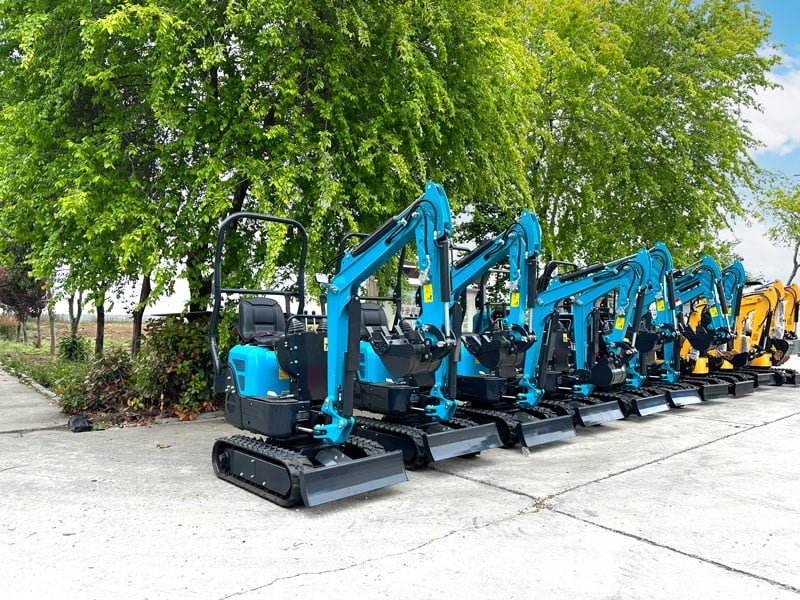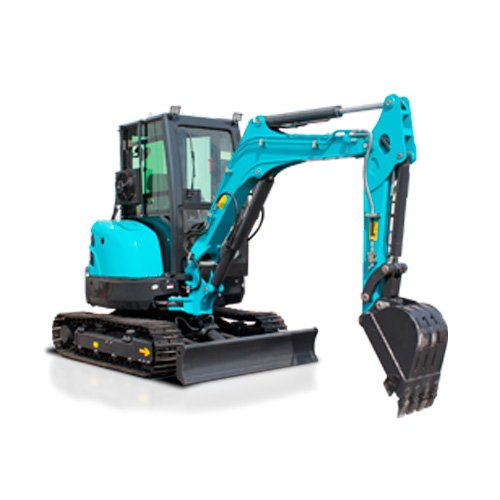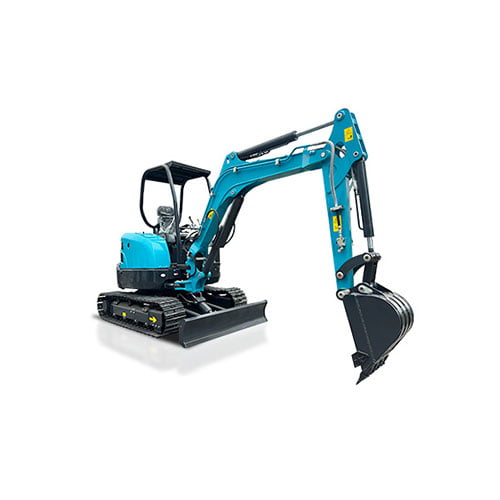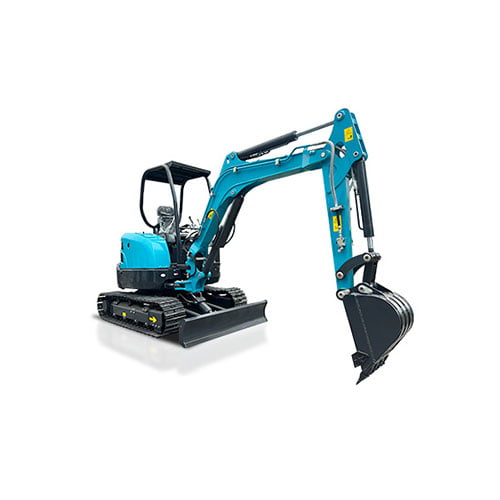Introducción
En el mundo de la construcción y la excavación, las miniexcavadoras se han convertido en herramientas indispensables por su tamaño compacto, versatilidad y eficacia. Un factor crucial que influye significativamente en su rendimiento es su peso. El peso de una miniexcavadora puede influir en varios aspectos de su funcionamiento, desde la estabilidad y la eficiencia del combustible hasta la maniobrabilidad y la productividad general. En este blog, exploraremos cómo el peso de una miniexcavadora afecta a su rendimiento, proporcionando información para ayudarle a tomar decisiones informadas a la hora de seleccionar el equipo adecuado para sus necesidades.
Comprender Mini Excavator Weight

What is Mini Excavator Weight?
Mini excavator weight refers to the total mass of the machine, including all standard equipment and fluids. It is typically measured in tons or kilograms and is a critical specification provided by manufacturers. The weight of a mini excavator is influenced by its size, engine type, materials used in construction, and additional attachments or features.
Importance of Mini Excavator Weight
The weight of a mini excavator plays a vital role in determining its capabilities and limitations. A heavier excavator may offer greater stability and digging power, while a lighter one can be more fuel-efficient and easier to transport. Understanding the importance of weight can help operators choose the right machine for specific tasks and job sites.
Factores que influyen Mini Excavator Weight
Engine and Components
The engine and other major components, such as the hydraulic system, significantly contribute to the overall weight of a mini excavator. High-powered engines and robust hydraulic systems add to the machine’s weight but also enhance its performance and capability to handle challenging tasks.
Material and Build Quality
The materials used in constructing the mini excavator’s frame and body also affect its weight. Machines made with high-strength steel or other heavy-duty materials are heavier but offer increased durability and longevity. Conversely, lightweight materials can reduce the overall weight but may compromise on strength and durability.
Fijaciones y accesorios
Attachments like buckets, augers, and breakers add to the mini excavator’s weight. Choosing the right attachments for specific tasks is essential to maintain the balance between weight and performance. Additional accessories, such as protective cabs or extended arms, also contribute to the overall weight.
How Miniexcavadora Weight Affects Performance
Stability and Balance
Stability in Various Terrains
A heavier mini excavator generally offers better stability, especially on uneven or challenging terrains. The added weight lowers the center of gravity, reducing the risk of tipping over during operations. This stability is crucial when working on slopes or handling heavy loads.
Balance During Operations
The weight distribution of a mini excavator affects its balance during operations. A well-balanced machine ensures smooth and precise movements, enhancing productivity and reducing the risk of accidents. Proper weight distribution is essential for tasks that require delicate maneuvering, such as trenching or landscaping.
Fuel Efficiency and Operating Costs
Consumo de combustible
The weight of a mini excavator directly impacts its fuel consumption. Heavier machines require more power to operate, leading to higher fuel consumption. Conversely, lighter excavators are generally more fuel-efficient, making them cost-effective for long-term use.
Maintenance and Operating Costs
Heavier mini excavators may experience increased wear and tear on components, leading to higher maintenance costs. The added weight can strain the engine, hydraulic system, and tracks, requiring more frequent servicing and part replacements. Understanding these costs is essential for budgeting and long-term planning.
Transportation and Mobility

Facilidad de transporte
The weight of a mini excavator affects its ease of transport between job sites. Lighter machines are easier to load onto trailers and can be towed by smaller vehicles, reducing transportation costs and logistical challenges. Heavier machines may require specialized transport equipment and permits.
Maneuverability on Job Sites
Lighter mini excavators offer better maneuverability, especially in confined spaces or urban environments. They can navigate tight areas and make precise movements, making them ideal for residential or commercial projects with space constraints. Heavier machines may face challenges in such environments.
Productivity and Efficiency
Digging and Lifting Capacity
The weight of a mini excavator influences its digging and lifting capacity. Heavier machines typically have more powerful engines and hydraulic systems, allowing them to handle larger and deeper excavations. This increased capacity enhances productivity on demanding job sites.
Cycle Times and Operational Speed
Lighter mini excavators often have faster cycle times and operational speeds due to their reduced weight. This speed can improve overall efficiency, allowing operators to complete tasks more quickly. However, it is essential to balance speed with stability and precision to achieve optimal performance.
Comparison of Different Miniexcavadora Weights
The table below compares the performance characteristics of mini excavators with different weight categories:
| Weight Category | Estabilidad | Eficiencia de combustible | Transportabilidad | Digging Capacity | Maniobrabilidad |
|---|---|---|---|---|---|
| Light (1-2 tons) | Moderado | Alta | Excelente | Moderado | Excelente |
| Medium (2-4 tons) | Alta | Moderado | Bien | Alta | Bien |
| Heavy (4-6 tons) | Excelente | Bajo | Moderado | Excelente | Moderado |
Conclusión
The weight of a mini excavator is a critical factor that affects its performance, stability, fuel efficiency, and overall productivity. When selecting a mini excavator for your project, it is essential to consider the specific requirements of the job site and the tasks at hand. Understanding how weight influences performance can help you make informed decisions, ensuring that you choose the right machine to meet your needs.
PREGUNTAS FRECUENTES
¿Cómo puede miniexcavadora weight impact fuel consumption?
The weight of a mini excavator directly affects its fuel consumption. Heavier machines require more power to operate, leading to higher fuel consumption. Lighter excavators are generally more fuel-efficient, making them cost-effective for long-term use.
What is the ideal weight for a mini excavator?
The ideal weight for a mini excavator depends on the specific tasks and job site conditions. For projects requiring high stability and digging capacity, a heavier machine may be ideal. For tasks requiring maneuverability and ease of transport, a lighter machine may be preferable.
How does weight influence the stability of a mini excavator?
A heavier mini excavator generally offers better stability, especially on uneven or challenging terrains. The added weight lowers the center of gravity, reducing the risk of tipping over during operations. This stability is crucial when working on slopes or handling heavy loads.
Can attachments affect the weight of a miniexcavadora?
Yes, attachments like buckets, augers, and breakers add to the mini excavator’s weight. Choosing the right attachments for specific tasks is essential to maintain the balance between weight and performance. Additional accessories, such as protective cabs or extended arms, also contribute to the overall weight.
How does mini excavator weight affect transportation?
The weight of a mini excavator affects its ease of transport between job sites. Lighter machines are easier to load onto trailers and can be towed by smaller vehicles, reducing transportation costs and logistical challenges. Heavier machines may require specialized transport equipment and permits.




